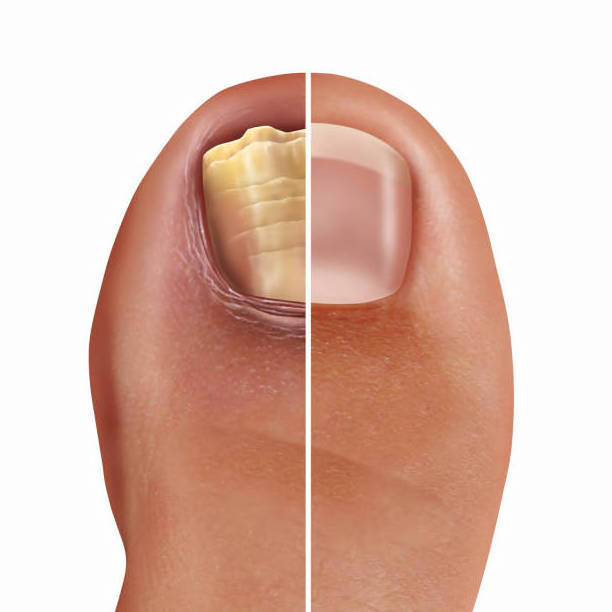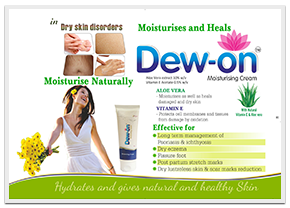
Onychomycosis
Onychomycosis (also known as "dermatophytic onychomycosis, ringworm of the nail and tinea unguium") means fungal infection of the nail. It is the most common disease of the nails and constitutes about a half of all nail abnormalities. This condition may affect toenails or fingernails, but toenail infections are particularly common. The prevalence of onychomycosis is about 6-8% in the adult population. There are four classic types of onychomycosis:
- Distal subungual onychomycosis is the most common form of tinea unguium, and is usually caused by Trichophyton rubrum, which invades the nail bed and the underside of the nail plate.
- White superficial onychomycosis (WSO) is caused by fungal invasion of the superficial layers of the nail plate to form "white islands" on the plate. It accounts for only 10 percent of onychomycosis cases. In some cases, WSO is a misdiagnosis of "keratin granulations" which are not a fungus, but a reaction to nail polish that can cause the nails to have a chalky white appearance. A laboratory test should be performed to confirm.
- Proximal subungual onychomycosis is fungal penetration of the newly formed nail plate through the proximal nail fold. It is the least common form of tinea unguium in healthy people, but is found more commonly when the patient is immune compromised.
- Candidal onychomycosis is Candida species invasion of the fingernails, usually occurring in persons who frequently immerse their hands in water. This normally requires the prior damage of the nail by infection or trauma.
Treatment for Onychomycosis
- Treatment of onychomycosis is challenging because the infection is embedded within the nail and is difficult to reach; full removal of symptoms is slow and may take a year or more, since new nail growth must entirely replace old, infected growth.
- Pharmacological - Most treatments are either systemic antifungal medications, such as clotrimazole,terbinafine and itraconazole, or topical, such as nail paints containing ciclopirox (ciclopiroxolamine) or amorolfine. There is evidence that combining systemic and topical treatments is beneficial. For superficial white onychomycosis, systemic rather than topical antifungal therapy is advised.
- There is some evidence ciclopiroxolamine and butenafine are both effective, but both need to be applied daily for prolonged periods (at least 1 year).
- There is evidence topical ciclopiroxolamine has poor cure rates, and that amorolfine might be substantially more effective.
- Further research into the effectiveness of antifungal agents for nail infections is required.
- A 2002 study compared the efficacy and safety of medication with terbinafine in comparison to placebo, itraconazole and griseofulvin in treating fungal infections of the nails. The main findings were for reduced fungus, terbinafine was found to be significantly better than itraconazole and griseofulvin, and terbinafine was better tolerated than itraconazole.
- A small study in 2004 showed ciclopirox nail paint was more effective when combined with topical urea cream.
- There is evidence topical ciclopiroxolamine has poor cure rates, and that amorolfine might be substantially more effective.
- A 2007 randomised clinical trial with 249 patients showed a combination of amorolfine nail lacquer and oral terbinafine enhanced clinical efficacy and is more cost-effective than terbinafine alone.
- Heat - Research suggests that fungi are sensitive to heat, typically 40-60°C. The basis of laser treatment is try to heating the nail bed to these temperatures in order to disrupt fungal growth.
- A Pinpointe type laser is available in the USA and approved by the FDA for onychomycosis treatment.
- A Noveon-type laser, already in use by physicians for some types of cataract surgery on the eye, is used by some podiatrists, although the only scientific study on its efficacy as of 2010, while showing positive results, included far too few test subjects for the laser to be proven generally effective.
- In 2011 several lasers were submitted for approval and two have been cleared by the Food and Drug Administration.
- Several companies have approval to market a Nd:YAG laser for onychomycosis treatment.
- The wavelength of light produced by the lasers trialled is in the visible or infra-red range, and insufficiently high to produce direct DNA damage as would be the case with ultra-violet lasers.
- If heating is an effective treatment, then there would be many other low technology, low cost methods available to raise the temperature of the nail bed, including infra-red heating, warm air heating etc.
Products



